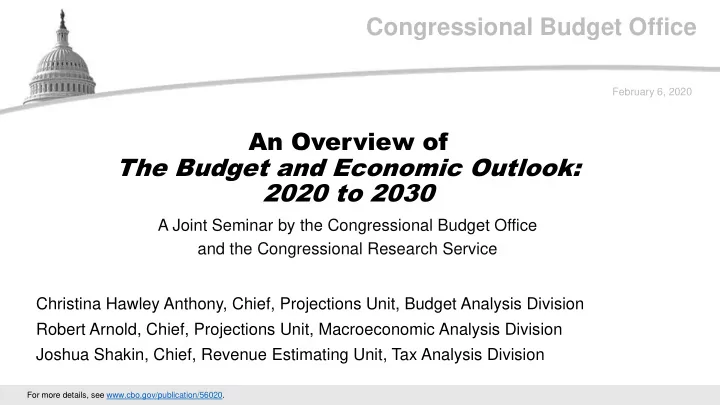

Congressional Budget Office February 6, 2020 An Overview of The Budget and Economic Outlook: 2020 to 2030 A Joint Seminar by the Congressional Budget Office and the Congressional Research Service Christina Hawley Anthony, Chief, Projections Unit, Budget Analysis Division Robert Arnold, Chief, Projections Unit, Macroeconomic Analysis Division Joshua Shakin, Chief, Revenue Estimating Unit, Tax Analysis Division For more details, see www.cbo.gov/publication/56020.
CBO The Congressional Budget Office 1
CBO CBO’s Role To provide the Congress with objective, nonpartisan, and timely analyses of legislative proposals and of budgetary and economic issues to support the Congressional budget process 2
CBO CBO’s Process for Developing the Budget Baseline 3
CBO What Is CBO’s Baseline? A detailed projection for the current year and the ensuing 10 years of federal spending, revenues, and the resulting deficits and surpluses Based on CBO’s economic forecast Incorporates the assumption that current laws governing taxes and spending generally remain in place Not a forecast of future budgetary outcomes; those depend on future Congressional action and other factors Generally provided two or three times a year Reported in the annual Budget and Economic Outlook and subsequent reports 4
CBO How Is the Baseline Constructed? Principles and rules mainly come from law, budget resolutions, House and Senate rules, and the 1967 Report of the President’s Commission on Budget Concepts. A key law is the Balanced Budget and Emergency Deficit Control Act, section 257. – Defines the baseline – Sets out rules for projecting spending and revenues – Requires an assumption of full funding for entitlements – Directs the treatment of expiring programs and certain excise taxes 5
CBO How Do CBO and the Congress Use the Baseline? A benchmark for measuring the budgetary effects of proposed changes in federal revenues and mandatory spending Basis for: – Cost estimates for proposed legislation – CBO’s analyses of the President’s annual budget – CBO’s budget options volume – Other reports (including those describing CBO’s long -term budget projections) – Assessments of multiyear budget trends Often a starting point for budget resolutions 6
CBO CBO’s Current Budget and Economic Outlook 7
CBO Baseline Projections Deficits and debt The economy Revenues Spending Policy alternatives 8
CBO Deficits and Debt 9
CBO Total Deficits and Surpluses When October 1 (the first day of the fiscal year) falls on a weekend, certain payments that would have ordinarily been made on that day are instead made at the end of September and thus are shifted into the previous fiscal year. All projections presented here have been adjusted to exclude the effects of those timing shifts. 10
CBO Total Deficit, Primary Deficit, and Net Interest When October 1 (the first day of the fiscal year) falls on a weekend, certain payments that would have ordinarily been made on that day are instead made at the end of September and thus are shifted into the previous fiscal year. All projections presented here have been adjusted to exclude the effects of those timing shifts. 11
CBO Total Revenues and Outlays When October 1 (the first day of the fiscal year) falls on a weekend, certain payments that would have ordinarily been made on that day are instead made at the end of September and thus are shifted into the previous fiscal year. All projections presented here have been adjusted to exclude the effects of those timing shifts. 12
CBO Federal Debt Held by the Public 13
CBO The Uncertainty of CBO’s Baseline Projections of the Budget Deficit When October 1 (the first day of the fiscal year) falls on a weekend, certain payments that would have ordinarily been made on that day are instead made at the end of September and thus are shifted into the previous fiscal year. All projections presented here have been adjusted to exclude the effects of those timing shifts. 14
CBO Changes in CBO’s Baseline Projection of the 10 -Year Deficit Since August 2019 15
CBO The Economy 16
CBO Real GDP and Real Potential GDP 17
CBO The Output Gap 18
CBO Composition of the Growth of Real Potential GDP 19
CBO The Unemployment Rate and the Natural Rate of Unemployment 20
CBO Inflation 21
CBO Interest Rates 22
CBO Revenues 23
CBO Changes in Projected Revenues From 2020 to 2030 * = between zero and 0.05 percentage points. 24
CBO Reasons for the Growth of Individual Income Tax Receipts in CBO’s Baseline Projections 25
CBO Outlays, Revenues, and Tax Expenditures in 2020 26
CBO Spending 27
CBO Federal Outlays, by Category 28
CBO Changes in Projected Outlays From 2020 to 2030 a. Consists of outlays for Medicare (net of premiums and other offsetting receipts), Medicaid, the Children’s Health Insuranc e Program, premium tax credits, and related spending. 29
Recommend
More recommend